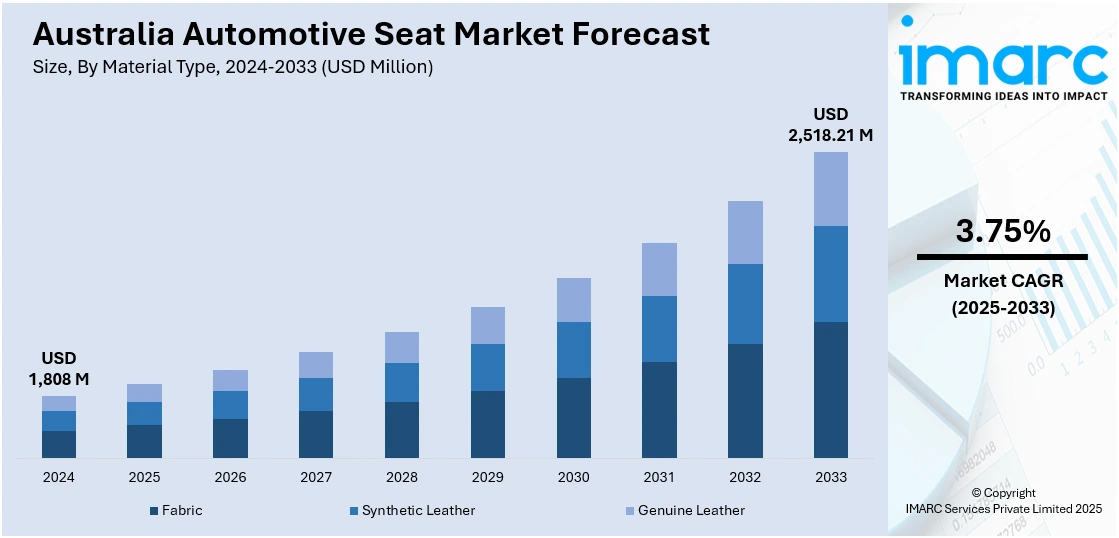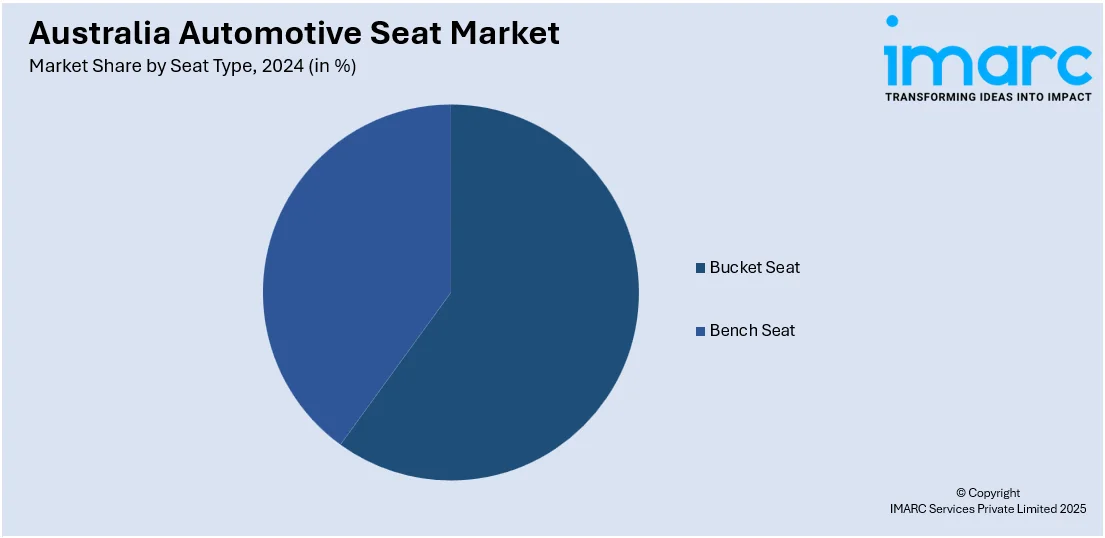
Australia Automotive Seat Market Size, Share, Trends and Forecast by Material Type, Seat Type, Vehicle Type, Vehicle Energy Source, and Region, 2025-2033
Australia Automotive Seat Market Overview:
The Australia automotive seat market size reached USD 1,808 Million in 2024. Looking forward, IMARC Group expects the market to reach USD 2,518.21 Million by 2033, exhibiting a growth rate (CAGR) of 3.75% during 2025-2033. The growing demand for vehicles equipped with advanced comfort and safety features, move toward sustainable mobility, rising research and development (R&D), and technological innovations and advancements in material production and designs are expanding the Australia automotive seat market share.
|
Report Attribute
|
Key Statistics
|
|---|---|
|
Base Year
|
2024 |
|
Forecast Years
|
2025-2033
|
|
Historical Years
|
2019-2024
|
| Market Size in 2024 | USD 1,808 Million |
| Market Forecast in 2033 | USD 2,518.21 Million |
| Market Growth Rate 2025-2033 | 3.75% |
Australia Automotive Seat Market Trends:
Increasing Need for Enhanced Comfort and Safety Features
The escalating demand for vehicles equipped with improved comfort and safety features is impelling the growth of the market in Australia. Automakers are continuously integrating innovations such as ergonomic designs, heating and cooling systems, lumbar support, and massage functionalities to enhance the driving experience. Simultaneously, heightened awareness regarding vehicle safety is prompting manufacturers to incorporate advanced airbag-compatible seating and energy-absorbing structures. Regulatory bodies are also enforcing stringent safety standards, encouraging the use of technologically advanced seating systems. This trend is encouraging original equipment manufacturers (OEMs) to invest in the development of seats that not only provide physical comfort but also enhance overall vehicle safety. As a result, the focus on improving passenger experience through sophisticated seating solutions is consistently driving the market. Additionally, the growing popularity of luxury and premium vehicles in Australia is further driving the demand for high-end automotive seats with superior comfort and safety features. The IMARC Group predicts that the Australian luxury car market size is expected to reach USD 13.2 Billion by 2033.

To get more information on this market, Request Sample
Rising Adoption of Electric and Hybrid Vehicles
The demand for automotive seats is increasing as more electric and hybrid cars are being adopted. As concerns about the environment are increasing and governments offer incentives to buy green vehicles, people are turning towards electric and hybrid vehicles in large numbers. These cars tend to have advanced and lightweight seating technologies that help increase energy efficiency and improve vehicle range. Automotive seat companies are designing unique products with specified features for electric vehicles (EVs) like smart technology-enabled seats and lightweight seats made of carbon fiber composites. Further, the move toward sustainable mobility is promoting research and development (R&D) spending in greener materials and module-based seating approaches. This shift is also impacting compact and flexible seat design that harmonizes with spatial optimization requirements for EV interiors. As a result, a rise in the sales of electric and hybrid vehicles is providing newer opportunities for the growth of Australia automotive seats market. The 2025 figures from the Federal Chamber of Automotive Industries (FCAI) and the Electric Vehicle Council indicate that in Australia 5,684 full battery EVs were sold during February, down from 10,111 in February last year, when Tesla ruled supreme and comprised 5,665 units.
Technological Advancements and Material Innovations
Technological innovations and advancements in material are contributing to the Australia automotive seat market growth. Industry players are using more advanced technologies like seat memory settings, biometric sensors, and climate control systems in greater numbers to upgrade user experience and car customization. At the same time, there is a greater focus on utilizing sustainable, durable, and lightweight material to satisfy the environmental requirements and enhance vehicle performance. Innovations such as 3D knitting technology, eco-friendly synthetic leathers, and intelligent fabrics with in-built sensors are transforming seating design and functionality. Car manufacturers are also concentrating on modular and adjustable seat configurations to suit varied tastes and trends toward shared mobility and autonomous driving. The ongoing quest for merging beauty and functionality is encouraging manufacturers to team up with tech companies and material science firms.
Australia Automotive Seat Market Segmentation:
IMARC Group provides an analysis of the key trends in each segment of the market, along with forecasts at the country and regional levels for 2025-2033. Our report has categorized the market based on material type, seat type, vehicle type, and vehicle energy source.
Material Type Insights:
- Fabric
- Synthetic Leather
- Genuine Leather
The report has provided a detailed breakup and analysis of the market based on the material type. This includes fabric, synthetic leather, and genuine leather.
Seat Type Insights:

- Bucket Seat
- Bench Seat
A detailed breakup and analysis of the market based on the seat type have also been provided in the report. This includes bucket seat and bench seat.
Vehicle Type Insights:
- Passenger Vehicle
- Commercial Vehicle
A detailed breakup and analysis of the market based on the vehicle type have also been provided in the report. This includes passenger vehicle and commercial vehicle.
Vehicle Energy Source Insights:
- Gasoline
- Diesel
- Electric
- Others
A detailed breakup and analysis of the market based on the vehicle energy source have also been provided in the report. This includes gasoline, diesel, electric, and others.
Regional Insights:
- Australia Capital Territory & New South Wales
- Victoria & Tasmania
- Queensland
- Northern Territory & Southern Australia
- Western Australia
The report has also provided a comprehensive analysis of all the major regional markets, which include Australia Capital Territory & New South Wales, Victoria & Tasmania, Queensland, Northern territory & Southern Australia, and Western Australia.
Competitive Landscape:
The market research report has also provided a comprehensive analysis of the competitive landscape. Competitive analysis such as market structure, key player positioning, top winning strategies, competitive dashboard, and company evaluation quadrant has been covered in the report. Also, detailed profiles of all major companies have been provided.
Australia Automotive Seat Market Report Coverage:
| Report Features | Details |
|---|---|
| Base Year of the Analysis | 2024 |
| Historical Period | 2019-2024 |
| Forecast Period | 2025-2033 |
| Units | Million USD |
| Scope of the Report |
Exploration of Historical Trends and Market Outlook, Industry Catalysts and Challenges, Segment-Wise Historical and Future Market Assessment:
|
| Material Types Covered | Fabric, Synthetic Leather, Genuine Leather |
| Seat Types overed | Bucket Seat, Bench Seat |
| Vehicle Types Covered | Passenger Vehicle, Commercial Vehicle |
| Vehicle Energy Sources Covered | Gasoline, Diesel, Electric, Others |
| Regions Covered | Australia Capital Territory & New South Wales, Victoria & Tasmania, Queensland, Northern territory & Southern Australia, Western Australia |
| Customization Scope | 10% Free Customization |
| Post-Sale Analyst Support | 10-12 Weeks |
| Delivery Format | PDF and Excel through Email (We can also provide the editable version of the report in PPT/Word format on special request) |
Key Questions Answered in This Report:
- How has the Australia automotive seat market performed so far and how will it perform in the coming years?
- What is the breakup of the Australia automotive seat market on the basis of material type?
- What is the breakup of the Australia automotive seat market on the basis of seat type?
- What is the breakup of the Australia automotive seat market on the basis of vehicle type?
- What is the breakup of the Australia automotive seat market on the basis of vehicle energy source?
- What is the breakup of the Australia automotive seat market on the basis of region?
- What are the various stages in the value chain of the Australia automotive seat market?
- What are the key driving factors and challenges in the Australia automotive seat market?
- What is the structure of the Australia automotive seat market and who are the key players?
- What is the degree of competition in the Australia automotive seat market?
Key Benefits for Stakeholders:
- IMARC’s industry report offers a comprehensive quantitative analysis of various market segments, historical and current market trends, market forecasts, and dynamics of the Australia automotive seat market from 2019-2033.
- The research report provides the latest information on the market drivers, challenges, and opportunities in the Australia automotive seat market.
- Porter's five forces analysis assist stakeholders in assessing the impact of new entrants, competitive rivalry, supplier power, buyer power, and the threat of substitution. It helps stakeholders to analyze the level of competition within the Australia automotive seat industry and its attractiveness.
- Competitive landscape allows stakeholders to understand their competitive environment and provides an insight into the current positions of key players in the market.
Need more help?
- Speak to our experienced analysts for insights on the current market scenarios.
- Include additional segments and countries to customize the report as per your requirement.
- Gain an unparalleled competitive advantage in your domain by understanding how to utilize the report and positively impacting your operations and revenue.
- For further assistance, please connect with our analysts.
 Request Customization
Request Customization
 Speak to an Analyst
Speak to an Analyst
 Request Brochure
Request Brochure
 Inquire Before Buying
Inquire Before Buying




.webp)




.webp)












